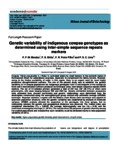Please use this identifier to cite or link to this item:
http://www.alice.cnptia.embrapa.br/alice/handle/doc/1029936| Title: | Genetic variability of indigenous cowpea genotypes as determined using inter-simple sequence repeats markers. |
| Authors: | MENDES, R. F. M.  BRITTO, F. B.   FREIRE FILHO, F. R.   LIMA, P. S. da C.   |
| Affiliation: | R. F. M. Mendes, Universidade Federal do Piauí, Campus Universitário Ministro Petrônio Portella, Ininga, 64049-550, Teresina, PI; F. B. Britto, Universidade Federal do Piauí, Campus Universitário Ministro Petrônio Portella, Ininga, 64049-550, Teresina, PI; FRANCISCO RODRIGUES FREIRE FILHO, CPATU; PAULO SARMANHO DA COSTA LIMA, CPAMN. |
| Date Issued: | 2015 |
| Citation: | African Journal of Biotechnology, Nairobi, v. 14, n. 36, p. 2652-2661, Sep. 2015. |
| Description: | Cowpea [Vigna unguiculata (L.) Walp.] is cultivated widely by small farmers in the semiarid region of Northeastern Brazil for subsistence purposes, especially to complement the family income. However, owing to the limited availability of water in this region, there is an urgent need for novel highly productive drought-tolerant cultivars. The aim of the present study was to establish the genetic variability of 14 cowpea populations (60 indigenous genotypes from 13 microregions of Rio Grande do Norte and 4 domesticated cultivars produced by Embrapa) using inter-simple sequence repeats (ISSR) markers. The set of 13 selected primers generated a total of 257 loci, 247 (96.11%) of which were polymorphic, with sizes ranging between 200 and 2000 bp. Genetic similarities between accessions were estimated from Jaccard coefficients and genetic relationships were determined from the dendrogram constructed using the unweighted pair group method with arithmetic average (UPGMA) technique. Bayesian statistics coupled with the Markov chain Monte Carlo technique was applied to determine population structure, while the genetic variability was established by analysis of molecular variance. UPGMA analysis allowed the separation of the genotypes into three groups, but no relationship between the genetic and geographical distances was observed. The fixation index was considered intermediary (FST = 0.0818), the average heterozygosity was low (HS = 0.39) and the coefficient of endogamy was high (f = 92.6%). The results show the presence of genetic diversity among the studied populations and revealed that such variability could be attributed mainly to intra-population variability (91.82%). |
| Thesagro: | Feijão de corda Vigna Unguiculata |
| Keywords: | Diversidade genética Melhoramento de planta Estresse hídrico Drought stress Genetic diversity Plant improvement |
| ISSN: | 1684-5315 |
| DOI: | 10.5897/AJB2015.14671 |
| Type of Material: | Artigo de periódico |
| Access: | openAccess |
| Appears in Collections: | Artigo em periódico indexado (CPAMN)  |
Files in This Item:
| File | Description | Size | Format | |
|---|---|---|---|---|
| ArtigoSarmanhoAfricanJournalBiotechnology.pdf | 591.95 kB | Adobe PDF |  View/Open |









